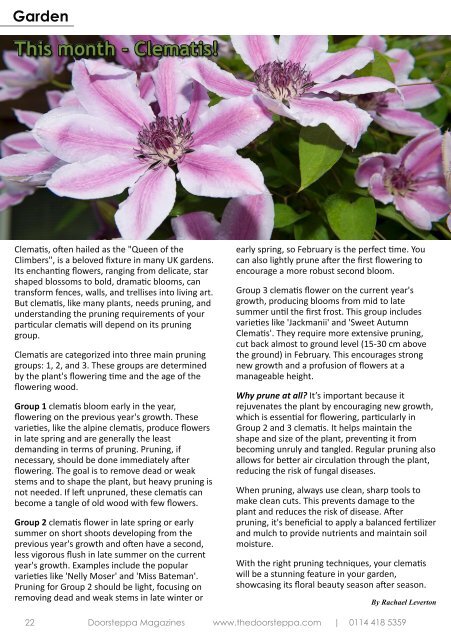Mosborough Feb 2024
Create successful ePaper yourself
Turn your PDF publications into a flip-book with our unique Google optimized e-Paper software.
Garden<br />
Clemas, oen hailed as the "Queen of the<br />
Climbers", is a beloved fixture in many UK gardens.<br />
Its enchanng flowers, ranging from delicate, star<br />
shaped blossoms to bold, dramac blooms, can<br />
transform fences, walls, and trellises into living art.<br />
But clemas, like many plants, needs pruning, and<br />
understanding the pruning requirements of your<br />
parcular clemas will depend on its pruning<br />
group.<br />
Clemas are categorized into three main pruning<br />
groups: 1, 2, and 3. These groups are determined<br />
by the plant's flowering me and the age of the<br />
flowering wood.<br />
Group 1 clemas bloom early in the year,<br />
flowering on the previous year's growth. These<br />
variees, like the alpine clemas, produce flowers<br />
in late spring and are generally the least<br />
demanding in terms of pruning. Pruning, if<br />
necessary, should be done immediately aer<br />
flowering. The goal is to remove dead or weak<br />
stems and to shape the plant, but heavy pruning is<br />
not needed. If le unpruned, these clemas can<br />
become a tangle of old wood with few flowers.<br />
Group 2 clemas flower in late spring or early<br />
summer on short shoots developing from the<br />
previous year's growth and oen have a second,<br />
less vigorous flush in late summer on the current<br />
year's growth. Examples include the popular<br />
variees like 'Nelly Moser' and 'Miss Bateman'.<br />
Pruning for Group 2 should be light, focusing on<br />
removing dead and weak stems in late winter or<br />
early spring, so <strong>Feb</strong>ruary is the perfect me. You<br />
can also lightly prune aer the first flowering to<br />
encourage a more robust second bloom.<br />
Group 3 clemas flower on the current year's<br />
growth, producing blooms from mid to late<br />
summer unl the first frost. This group includes<br />
variees like 'Jackmanii' and 'Sweet Autumn<br />
Clemas'. They require more extensive pruning,<br />
cut back almost to ground level (15-30 cm above<br />
the ground) in <strong>Feb</strong>ruary. This encourages strong<br />
new growth and a profusion of flowers at a<br />
manageable height.<br />
Why prune at all? It’s important because it<br />
rejuvenates the plant by encouraging new growth,<br />
which is essenal for flowering, parcularly in<br />
Group 2 and 3 clemas. It helps maintain the<br />
shape and size of the plant, prevenng it from<br />
becoming unruly and tangled. Regular pruning also<br />
allows for beer air circulaon through the plant,<br />
reducing the risk of fungal diseases.<br />
When pruning, always use clean, sharp tools to<br />
make clean cuts. This prevents damage to the<br />
plant and reduces the risk of disease. Aer<br />
pruning, it's beneficial to apply a balanced ferlizer<br />
and mulch to provide nutrients and maintain soil<br />
moisture.<br />
With the right pruning techniques, your clemas<br />
will be a stunning feature in your garden,<br />
showcasing its floral beauty season aer season.<br />
By Rachael Leverton<br />
22 Doorsteppa Magazines www.thedoorsteppa.com | 0114 418 5359
















